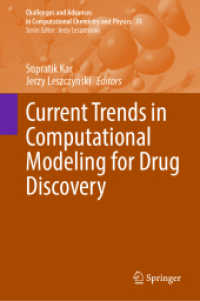- ホーム
- > 洋書
- > 英文書
- > Science / Mathematics
Full Description
Radar array design aims at shaping a specific transmit/receive beampattern through optimizing array geometry, transmit waveform, and transmit/receive weight vectors. It is a hot topic among the scientific and industrial communities due to the advent of modern digital arrays with multiple digital transmit and receive channels, arbitrary digital waveform generators, and solid-state transmitters. The radar array beampattern is a critical performance metric, and there has been a proliferation of techniques for radar array design exploiting the mathematical results drawn from optimisation theory.
This book provides an overview of radar beampattern synthesis based on optimised array design. Some of the most challenging application fields are explored, including phased array beampattern, multiple input multiple output (MIMO) beampattern in the presence of clutter, jamming, and congested environments. Innovative and sophisticated instruments from optimization theory, such as alternating direction method of multipliers (ADMM), coordinate descent technique, semidefinite relaxation, rank-one matrix decomposition, Lagrange duality theory, fractional programming, convex approximation, Pareto optimization, and machine learning (ML) are framed in the context of radar array design.
Providing a rigorous mathematical approach corroborated with a wealth of numerical study cases, chapters emphasize both theoretical results and practical applications, demonstrating the potential benefits achievable in radar array design through the utilization of modern optimization theory. A common list of symbols and extensive cross referencing has been undertaken so that the related material can be easily found. The cross-fertilization of recent research and discoveries in optimization theory is explored.
Radar Array Design using Optimization Theory is intended for systems engineers and their managers within the aerospace and defense sector, technical personnel in procurement agencies and their advisory teams, as well as academic researchers and students pursuing MSc and PhD degrees in signal processing, electrical engineering, and optimization theory.
Contents
Chapter 1: Machine learning-based antenna selection for sparse array reconfiguration
Chapter 2: Beampattern synthesis via the constrained subarray layout optimization
Chapter 3: Reconfigurable array beampattern synthesis via conceptual sensor network modeling and computation
Chapter 4: Shaped power pattern synthesis with minimization of dynamic range ratio
Chapter 5: Array beampattern synthesis with shape constraints and excitation range control
Chapter 6: Pattern synthesis via array response control
Chapter 7: Wideband beampattern synthesis using single digital beamformer with integer time delay filters
Chapter 8: Hybrid beamforming design for dual-function radar-communication system
Chapter 9: Robust beamforming design for dual-function radar-communication system
Chapter 10: Optimization of sparse MIMO array for enhanced sensing
Chapter 11: Transmit-receive beamforming for distributed phased-MIMO radar system







